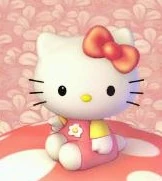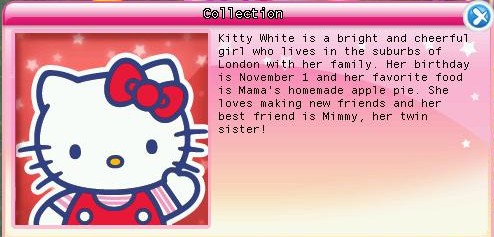"Hello Kitty" not only is a trademark-character kitten contrived by Sanrio Co. Ltd. (Japan) but is also the name of the famous white female kitten that "Hello Kitty Online" is all about.

It is the objective of the game HKO to find and free Hello Kitty, who can be discovered as one of the sleeping NPCs somewhere on Sanrio Land in the game. After finding Hello Kitty in the game of HKO she will explain the storyline behind "Hello Kitty Online" and she will also describe the line of events that made NPCs fall asleep and let the keys to their houses vanish.
In the tutorial-area Dream Carnival (which is presented as a "dream" your character has before entering Sanrio Land) you will meet Hello Kitty for the first time as an NPC very early in the game. She will give your character/avatar some quests to do.
You wil also find another Hello Kitty in the newest city New York. New York is aimed at high-level players considering the high-level content and quests with much "grind" there. But New York can also be entered by low-level characters through West Misty Land and some of the quests of New York can be accomplished by low-level chars as well. They can even play through all of New York by either being very patient & getting help from high-level players or by buying stuff in the Item-Mall.
There may be even more Hello Kittys in the game at time of events! Most events will start at Sanrio Harbour. Please check the HKO-news [1] to see if there is an event in progress on HKO right now.

About:
Hello Kitty was designed in 1974 by Yuko Shimizu from Sanrio, a japanese company. The trademark was registered in 1976. Hello Kitty is also called "Kitty White", and her family carries the surname "White" as well. Kitty is a talking bobtail cat with a - most often red - bow on her left ear as an identification. This also differs her from her twin sister Mimmy who wears a yellow bow on her right ear most of the times.

The fictional date of birth of Hello Kitty is November 1st. She is a well-behaved friendly girl, likes small cute things, loves music and reading. Her motto is "you can never have too many friends". She likes to travel, her favorite food is the apple pie her mother bakes and also the cookies her sister Mimmy (or "Mimi") likes to bake. Her bloodtype is A. She is a generous character, who loves to make friends the most.

Hello Kitty and her twin sister were born in the suburbs of (a fictional version of) London and still live in London, where they are going to school. Kitty is very energetic and likes to play outdoors. When she's inside the house, she often practices piano or bakes a cake, but also likes to read. She is quite innocent, but also loves adventures and her kindness then easily wins over new friends. She likes to do tea parties as well as collecting small cute things like candy or goldfishes. Her weight ist 3 apples, her height 5 apples.
Kitty and Mimmy are friends with other well-known characters like the bunny My Melody (1975), the boy Minna no Tabo (1984), the frog Kerokero Keroppi (1988), the dog Pochacco (1989), the duck Pekkle (1990), The penguin Badtz Maru (1993), the dog Purin (1996), the hamster CoroCoro Kuririn (1998), the bunny Usahana (2001), the dog Cinnamoroll Cinnamon (2002), a more cat-like kitten called Charmmy Kitty (2004) and many,many others. You can meet most of them in Hello Kitty Online.
Hello Kitty is the "U.S. children's ambassador for UNICEF" since 1983.
Since Hello Kitty and her whole family are white cats, there's no doubt that they represent housecats (felis catus). Cats have been with humans for at least 9.500 years, since a kitten was found buried with a human in Cyprus. So it is conjectured that domestic cats might descend from only a few african wildcats (felis silvestris lybica) in the Near East.
Also Asiatic Wildcats (Felis silvestris ornata) and other wildcats could have been domesticated and interbred with other domestic cats over time. Cats are now the most popular pets in this world, even more than dogs. It is reckoned that there must be up to 500 million house-cats in this world today. Not all of them are living with humans though, like in Australia or New Zealand.
Cats are still bred by humans into different races and registered as "pedigree" pets at cat-shows, where they are given prices for beauty, measured by different detailled "standards". Even though cats are quite idiosyncratic in nature compared to pets like dogs, cat can be trained too when treated with love and lots of rewards for desired behaviour.
Like most predators cats can be active at day and at night, in the wild the tend to be more active at dusk and at night. As everyone knows cats sleep a lot to save energy; otherwise they would need to hunt much more prey to stay strong and healthy. It is believed that cats are dreaming during their sleeps just like humans, as they show rapid eye movement, can twitch their feet, pule or purr while sleeping sometimes.
Domestic cats can live together well in groups of different sizes; although wild cats are living solitary. In each group of cats there are only a few dominant cats. To decide which cat is dominant even female domestic cats may fight, although between wildcats only males use to fight each other. But even domestic cats don't cooperate while hunting, and they generally don't feed other full-grown cats like individuals that are old or sick. They may bring humans who feed them "presents" of dead prey sometimes though.
Each cat has its own territory, varying in size a lot, depending on the personality of the cat itself. Males have larger territories which may overlap with several territories of female cats. Between territories some neutral spaces are possible. Cats mark their territories with rubbing their faces on objects and with spraying urine.
Feral cats are usually silent and prefer to stay hidden, while domestic cats have differentiated forms of communication, many forms of meows, of hissing, growling, but also purring and body language. Its quite easy to see in what kind of mood a cat is because of its behaviour, position of tail, ears and fur.
Cats will raise their tailes as a friendly greeting; while dominant cats raise their tailes even more often than subordinate cats. Nose-touching is a common greeting for close friends or the own social group. Not all cats are friendly or can communicate well in social groups though.
Some cats, especially when getting older, may get more agressive frequently, especially against newcomer-cats, even kittens. This behaviour is called "Feline Asocial Aggression". Also some cats can be quick to scratch when woken up suddenly from their sleep. So be careful when trying to pet a cat that isn't used to you!
It is resumed that in ancient times cats started to follow humans like foxes or rats also sometimes do by themselves, feeding on wastes of human meals. They might have "self-domesticated" and/or they were taken in as pets because cats would hunt small rodents and even insects that were a threat to human reservoirs of comestible goods.
But some other humans have evidentially hunted cats for food and might have then started to breed cats for this purpose. In Australia, in India, in northern Vietnam, in southern China and in Peru, cats are still being eaten today.
Today cats are also still kept for their fur (fur farming) in some regions of the world. Only since december 31st 2008 no fur of cats or dogs is allowed to be imported to the EU or exported from the EU anymore. The USA already banned sales of dog and cat fur-products in 2000.
